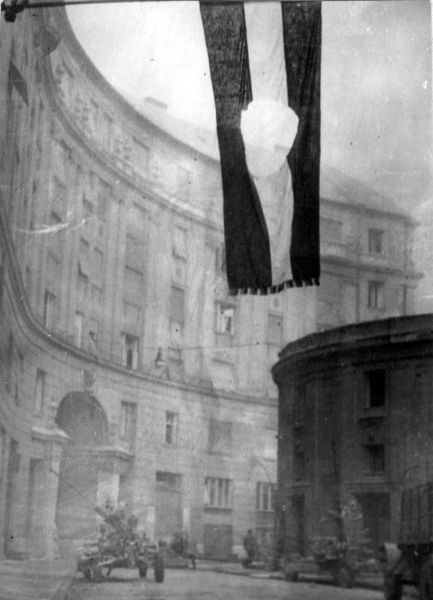From Wikipedia, the free encyclopedia
The national flag of Romania (Romanian: drapelul României) is a tricolor with vertical stripes, beginning from the flagpole: blue, yellow and red. It has a width-length ratio of 2:3.
The Constitution of Romania provides that "The flag of Romania is tricolor; the colors are arranged vertically in the following order from the flagpole: blue, yellow, red, with a centered circular hole". The proportions, shades of color as well as the flag protocol were established by law in 1994 and extended in 2001.
The flag of Moldova is related to the Romanian tricolor, except it has a 1:2 ratio, a lighter shade of blue, a slightly different tint of yellow, and the Moldovan coat of arms in the middle.
The flag of Romania is only one of the two non-quadrilateral national flags; the second being the flag of Nepal. However, the outer shape of the flag of Romania is rectangular.
The flag holds the distinction of being the only national or subnational flag in the world that is not simply connected.

National Flag of Romania
History of the Flag
The tricolor was first adopted in Wallachia in 1834, when the domnitor Alexandru II Ghica submitted naval and military colors designs for the approval of Sultan Mahmud II.
From 1859 until 1866, the United Principalities of Wallachia and Moldavia had a red-yellow-blue Romanian tricolor, with horizontal stripes, as national flag.
The 1866 Constitution of Romania provided that "the colors of the United Principalities will be Blue, Yellow and Red". The country's coat of arms was placed only on army and princely flags, in the center; civilian flags remained without a coat of arms. This design of the national flag lasted until 1948.
On 30 December 1947, Romania was proclaimed a people's republic and all the ex-kingdom's symbols were outlawed, including the coat of arms and the tricolor flags that showed it. During the communist era in Romania, the state flag had the emblem of the country in the middle of the yellow stripe, and for the first time the 2:3 proportion was regulated by law. The coat of arms changed several times during the era.
Starting on 17 December 1989, during the revolution at Timișoara, the protesters began waving flags with the Communist coat of arms cut out of the middle. The coat of arms was perceived as a symbol of Nicolae Ceaușescu's dictatorial regime. These flags were called "the flag with the hole" (drapelul cu gaură).
Decree-Law no. 2 of 27 December 1989 regarding the membership, organization and functioning of the Council of the National Salvation Front and of the territorial councils of the National Salvation Front. provided at article 1, among other matters, that "the national flag is the traditional tricolor of Romania, with the colors laid out vertically, in the following order, starting from the flagpole: blue, yellow, red, with a centered circular hole representing the people's struggle for the liberation from decades long dictatorship".
The national flag of Romania (Romanian: drapelul României) is a tricolor with vertical stripes, beginning from the flagpole: blue, yellow and red. It has a width-length ratio of 2:3.
The Constitution of Romania provides that "The flag of Romania is tricolor; the colors are arranged vertically in the following order from the flagpole: blue, yellow, red, with a centered circular hole". The proportions, shades of color as well as the flag protocol were established by law in 1994 and extended in 2001.
The flag of Moldova is related to the Romanian tricolor, except it has a 1:2 ratio, a lighter shade of blue, a slightly different tint of yellow, and the Moldovan coat of arms in the middle.
The flag of Romania is only one of the two non-quadrilateral national flags; the second being the flag of Nepal. However, the outer shape of the flag of Romania is rectangular.
The flag holds the distinction of being the only national or subnational flag in the world that is not simply connected.

National Flag of Romania
History of the Flag
The tricolor was first adopted in Wallachia in 1834, when the domnitor Alexandru II Ghica submitted naval and military colors designs for the approval of Sultan Mahmud II.
From 1859 until 1866, the United Principalities of Wallachia and Moldavia had a red-yellow-blue Romanian tricolor, with horizontal stripes, as national flag.
The 1866 Constitution of Romania provided that "the colors of the United Principalities will be Blue, Yellow and Red". The country's coat of arms was placed only on army and princely flags, in the center; civilian flags remained without a coat of arms. This design of the national flag lasted until 1948.
On 30 December 1947, Romania was proclaimed a people's republic and all the ex-kingdom's symbols were outlawed, including the coat of arms and the tricolor flags that showed it. During the communist era in Romania, the state flag had the emblem of the country in the middle of the yellow stripe, and for the first time the 2:3 proportion was regulated by law. The coat of arms changed several times during the era.
Starting on 17 December 1989, during the revolution at Timișoara, the protesters began waving flags with the Communist coat of arms cut out of the middle. The coat of arms was perceived as a symbol of Nicolae Ceaușescu's dictatorial regime. These flags were called "the flag with the hole" (drapelul cu gaură).
Decree-Law no. 2 of 27 December 1989 regarding the membership, organization and functioning of the Council of the National Salvation Front and of the territorial councils of the National Salvation Front. provided at article 1, among other matters, that "the national flag is the traditional tricolor of Romania, with the colors laid out vertically, in the following order, starting from the flagpole: blue, yellow, red, with a centered circular hole representing the people's struggle for the liberation from decades long dictatorship".
Last edited:
